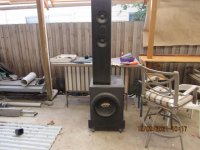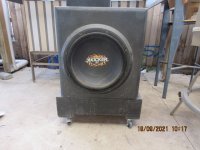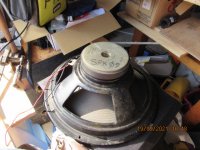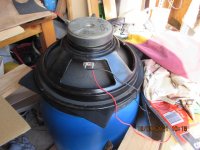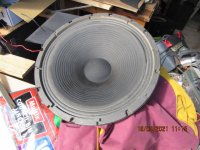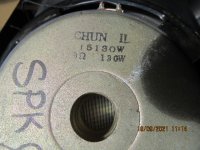But why? Doesn't each driver have a band within which it does near to the same as every other driver?that generalisation
Same argument applies to the so called new, modern, Hi-Fi drivers of today. How do you know they are faithful to the original sound?
Many are not. Some of the less 'advanced' drivers make better systems than some more expensive 'high end' drivers in my experience. I presume they sell because the drivers are designed by the engineers to have a good set of numbers for modelling, and people listen with their eyes on the specification sheets (composed of course by the manufacturers' marketing departments).
This to me sounds like the argument some people had a few years back when they said: CD produces the perfect sound forever and went ahead and tried to trash everything vinyl.
Whilst I do stream background music, I only ever sit down to listen to vinyl, and then not vinyl from digital masters or analogue recordings digitally remastered. Back in the mid 1980s I was demonstrating the superiority of vinyl by syncing records to CDs and letting listeners choose which they thought was better. Most, if not all, picked the vinyl version as the CD, because reputedly CD sounded better! Obviously I had to avoid playing groove noise between tracks, which would have been a giveaway.
So at the end I assume you have no experience with old drivers and how to properly use them.
Back in ~1965 I upgraded the family AWA valve radiogram with new tubes and replaced a Rola 8" with a Maganvox Twin Cone. Shortly after I built my first bass reflex system. Over the ensuing decades I have worked with and/or for quite a few loudspeaker manufacturers, and in the '80s and 90's I served on the committee of the Audio Engineering Society, Adelaide Section, for around 10 or 12 years. One of the more interesting events the Adelaide Section organised was a presentation by Neville Thiele on the mis-measurement and misapplication of the ubiquitous Thiele/Small loudspeaker parameters. (See comment above on loudspeaker numbers.) I also presented for the AES a comparison of professional loudspeakers (Meyer, Electro-Voice, Apogee, Nexo and Tannoy) carefully designed to comply with AES double blind recommendations, at Her Majesty's Theatre in Adelaide. The evaluations of a large cohort of audio professionals left a few distributors red-faced when they could not identify their own prized 'top shelf' products and picked someone else's as theirs, presumably because they sounded better.
BTW I have a soft spot for the Barossa as I went to school in Nuriootpa. The Institute Hall there had a big post WWII cinema screen system of multi-cellular horn and (from memory) 15" drivers. I always dreamed of taking it up Manglers Hill and blasting the Valley. Of course they wouldn't have made that much noise before frying as they were probably rated to run off a small valve amp.
Last edited:
That sounds like asking: Doesn't each passenger car have a realm within which it does near to the same as every other passenger car? Well maybe, but...But why? Doesn't each driver have a band within which it does near to the same as every other driver?
I suppose it might. What are some of the things?
Many are not. Some of the less 'advanced' drivers make better systems than some more expensive 'high end' drivers in my experience.
Mostly time domain performance issues, i.e. resonances and break-up modes. If there are anomalies outside of the desired passband, it's likely the driver will be quite coloured.I suppose it might. What are some of the things?
I've worked with expensive "high end" drivers with response peaks more than 20dB higher than the passband level. There's not a hope that a driver like that can get a voice, a trumpet, a snare or a cymbal to sound natural, no matter how pleasant a clever designer might make the 'system' sound.
For a simple experiment listen to the acoustic sound of a triangle being struck, then listen to a struck triangle played through a loudspeaker system. Those systems with poor time domain performance turn a 'ting' sound into a 'tish' sound. Once you have aurally identified and memorised this defect, it is surprisingly common. There's a version of a similar anomaly for every instrument or sound with significant transient energy, which collectively will unmask all manner of speaker defects, even in some well regarded and expensive systems.
Thanks for clarifying, I understand more about post #13. I take it that these are these the things that work together with an instrument that form part of the sound of that instrument. Apart from looking at audibility, what if the time domain performance was fixed?
Hello John. Apologies for my earlier remark. I didn't mean it to be personal, although re-reading it now it indeed sounds out of order.
I am at the southern end of the valley, looking after my vineyard and building speakers for fun. If you ever come this way PM me and I'll be delighted to meet you for a chat and a glass or two of the wine that I produce.
Cheers
Stan
I am at the southern end of the valley, looking after my vineyard and building speakers for fun. If you ever come this way PM me and I'll be delighted to meet you for a chat and a glass or two of the wine that I produce.
Cheers
Stan
Thanks Stan, invite much appreciated!If you ever come this way PM me and I'll be delighted to meet you for a chat and a glass or two of the wine that I produce. Cheers Stan
I'm not sure what the context of the question is, or whether I can answer it.Apart from looking at audibility, what if the time domain performance was fixed?
My beloved wife has suggested I make a big party speaker with this.
If I use OB would crossing at 120/150 be too low?
I have the a 5.6mH and a 9mH on the shelf and could find some bloddy great big caps for a 2nd electrical on the mid, I have some cheap tweeters to fill in the top; the woofer would be the old Kicker 15 in the 220 litre sealed box.
OR
Should I run the driver full range and simply add in the Kicker as a .5 driver?
If I use OB would crossing at 120/150 be too low?
I have the a 5.6mH and a 9mH on the shelf and could find some bloddy great big caps for a 2nd electrical on the mid, I have some cheap tweeters to fill in the top; the woofer would be the old Kicker 15 in the 220 litre sealed box.
OR
Should I run the driver full range and simply add in the Kicker as a .5 driver?
THIS-THREAD-IS-WORTHLESS-WITHOUT-PICTURES 😀
Show front-back-side and any inscription on it, even if a small rubber stamp or written with chalk on the cone, all matter.
Show front-back-side and any inscription on it, even if a small rubber stamp or written with chalk on the cone, all matter.
As requested some pix
The old tops sitting on the sub box are a pair of old Tandy 8" drivers; sold as a subwoofer but actually a damned good efficient midrange.
The old tops sitting on the sub box are a pair of old Tandy 8" drivers; sold as a subwoofer but actually a damned good efficient midrange.
Attachments
Looking serious. Vented pole piece, big magnet.
Have you tested it to get the T/S parameters?
That and the impedance curve will tell you a lot about a probable application.
Have you tested it to get the T/S parameters?
That and the impedance curve will tell you a lot about a probable application.
- Home
- Loudspeakers
- Multi-Way
- Large full range from electric organ
